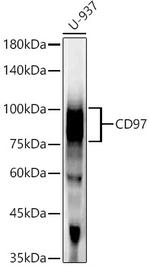Search Thermo Fisher Scientific
FIGURE: 1 / 1
CD97 Antibody (MA5-51373) in WB

Product Details
MA5-51373
Species Reactivity
Host/Isotype
Expression System
Class
Type
Clone
Immunogen
Conjugate
Form
Concentration
Purification
Storage buffer
Contains
Storage conditions
Shipping conditions
RRID
Product Specific Information
Immunogen sequence: QDSRGCARWC PQNSSCVNAT ACRCNPGFSS FSEIITTPTE TCDDINECAT PSKVSCGKFS DCWNTEGSYD CVCSPGYEPV SGAKTFKNES ENTCQDVDEC QQNPRLCKSY GTCVNTLGSY TCQCLPGFKF IPEDPKVCTD VNECTSGQNP CHSSTHCLNN VGSYQCRCRP GWQPIPGSPN GPNNTVCEDV DECSSGQHQC DSSTVCFNTV GSYSCRCRPG WKPRHGIPNN QKDTVCEDMT FSTWTPPPGV HSQTLSRFFD KVQDLGRDSK TSSAEVTIQN VIKLVDELME APGDVEALAP PVRHLIATQL LSNLEDIMRI LAKSLPKGPF TYISPSNTEL TLMIQERGDK NVTMGQSSAR MKLNWAVAAG AEDPGPAV
Target Information
CD97 is a G-protein-coupled seven-span transmembrane adhesive receptor that is constitutively expressed on granulocytes and monocytes and rapidly upregulated on T and B cells upon activation. CD97 is produced in alternatively spliced forms and its cellular ligand is CD55 (DAF), which protects various cell types from complement-mediated damage. Interaction of CD97 on leukocytes and CD55 on vessel cells probably facilitate leukocyte activation and migration into the tissues, similarly, CD97 seems to play a role in tumour migration and invasiveness. CD97 is involved in T cell regulation and peripheral granulocyte homeostasis.
For Research Use Only. Not for use in diagnostic procedures. Not for resale without express authorization.
References (0)
Bioinformatics
Protein Aliases: Adhesion G protein-coupled receptor E5; CD97; CD97 molecule; Leukocyte antigen CD97; seven transmembrane helix receptor; seven-span transmembrane protein; seven-transmembrane, heterodimeric receptor associated with inflammation
Gene Aliases: ADGRE5; CD97; TM7LN1
UniProt ID: (Human) P48960
Entrez Gene ID: (Human) 976

Performance Guarantee
If an Invitrogen™ antibody doesn't perform as described on our website or datasheet,we'll replace the product at no cost to you, or provide you with a credit for a future purchase.*
Learn more
We're here to help
Get expert recommendations for common problems or connect directly with an on staff expert for technical assistance related to applications, equipment and general product use.
Contact tech support
